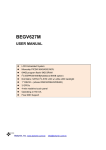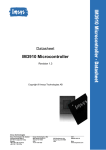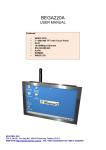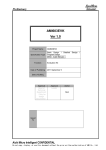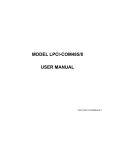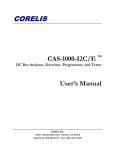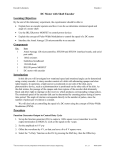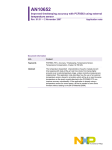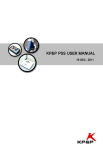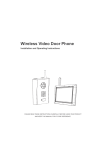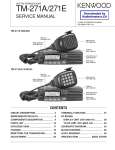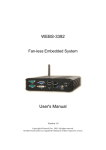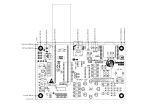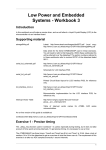Download begv643a user manual
Transcript
BEGV643A USER MANUAL LCD Embedded System, Atmel ATmega644p MCU, Graphic 320x240 STN LCD, LED/white backlight, RS232/RS422/RS485, I2C /SPI 64KB in-system programmable Flash No Operating System required Bolymin, Inc. www.bolymin.com.tw [email protected] CONTENTS P3 P4 P5 P6 P6 P7 P7 P8 P8 P9 Precaution Packing Contents Chapter 1 Introduction 1-1ʳ 1-2ʳ 1-3ʳ 1-4ʳ 1-5ʳ 1-6ʳ Features Board Layout Block Diagram Mechanical Dimension Board Specifications Ordering Information Chapter 2 Installation 2-1ʳ Jumpers P10 2-1-1 Contrast adjust 2-1-2 Frame ground 2-1-3 RS-422/485 VDD/ground 2-1-4 Screw hole ground 2-2ʳ Connectors 2-2-1 Connector & Pin Definition 2-2-2 Pin vs. Function Diagram Chapter 3 MCU Port Mapping 3-1 MCU Pin Configuration 3-2 MCU Port Mapping 3-2-1 LCD Controller 3-2-2 Touch Panel 3-2-3 RS-232/RS-422/RS-485 3-2-4 Enable Backlight 3-2-5 EEPROM/I2C 3-2-6 2-wire serial port 3-2-7 SPI 3-2-8 General I/O Chapter 4 Software Development Tool & Utility 4-1 ATMEL ATmega644p Tool 4-1-1 Download software from AVR studio website 4-1-2 Additional tool for C language 4-2 Execute AVR studio 4.16 on designer PC 4-3 In-system programmer AVR ISP mk II 4-4 Bolymin Free Software Utilities 4-4-1 Website links 4-4-2 Introduction of BOLYMIN software utilities 4-4-3 Software utilities function description Appendix A: LCD Controller Specification Appendix B: EEPROM Specification Appendix C: ATMEL ATmega644p MCU Specification BEGV643A User Manual Ver.02 -2- P10 P11 P11 P12 P12 P12 P16 P19 P20 P21 P21 P21 P21 P21 P21 P21 P22 P22 P23 P24 P24 P32 P36 P44 P62 P62 P63 P71 Precaution FCC WARNING CAUTION This device is designed to meet the requirement in part 15 of the FCC rules. Operation is subject to conditions ruled under FCC part 15. BEGV643A User Manual Ver.02 -3- Please check packing content upon receiving BEGV643A parcel, make sure that all materials and options are packed inside parcel according to your order. Packing Contents Check-List Ƒ BEGV643A LCD Embedded module Ƒ Touch panel Ƒ Software Utility Disc Ƒ ISP Cable (option) Ƒ ATMEL software development tool BEGV643A User Manual Ver.02 -4- Chapter 1 Introduction Abstract This chapter is to offer you basic information regarding BEGV643A, to help you incorporate BEGV643A into your system. Contents include: 1-1 Features 1-2 Board Layout 1-3 Block Diagram 1-4 Mechanical Dimension 1-5 Board Specifications 1-6 Ordering information BEGV643A User Manual Ver.02 -5- 1-1 Features This BEGV643A is designed based on ATmega644p microprocessor, which requires no operating system to run on. Together with a 320x240 STN LCD and LED backlight built-in, this all-in-one LCD embedded system BEGV643A help designer enhance a compact design with cost saving, space saving, and design phase saving. Armed with RS232, RS422/485, I2C and SPI interface port, this BEGV643A communicates many devices and peripherals. The BEGV643A is therefore suitable to sit as a industrial control panel for factory automation equipment, electronics instrument, HMI (human-machine interface), office automation equipment, medical equipment, parking system, ticketing system.. and so on. There are five LCD colors among choices: STN/gray, STN/yellow-green, STN/blue, FSTN/Positive, and FSTN/negative. All comes with LED/white backlight. 64KB in-system self-programmable Flash offers sufficient ROM size for designer to develop software, further to control LCD, touch panel, and interfaces. Designer may simply design this BEGV643A into your application as you are designing a ATMEL CPU board, without worrying LCD module and other interfaces, since they are all on one board. 1-2 Board Layout This layout shows the location of each important IC, connector and jumper. Please refer to chapter 2 for further information on jumper and connector. (Drawing 1.2) 7 1 6 1 :LCD controller 5 43 2 7 : CN2 2 :RS232 3: CN1 4 :Microprocessor 5 :RS-485/422 6 :EEPROM BEGV643A User Manual Ver.02 -6- 1-3 Block Diagram (Drawing 1.3) 1-4 Mechanical Dimension (Drawing 1.4) BEGV643A User Manual Ver.02 -7- 1-5 Board Specifications (Table 1.5) MCU Memory Display Touch Panel(optional) Serial Ports High-performance, Low-power AVR® 8-bit microprocessor ATMEL ATmega644P 64K Bytes In-System Self-Programmable Flash 2K Bytes Internal EEPROM 4K Bytes Internal SRAM 3 x 64K Bytes External EEPROM(optional) Support 8-bit single-scan resolution 320 x 240 monochrome STN LCD, with edge LED white backlight only Support four-wired resistive touch panel Support 1 x RS232 port, and 1 x RS232/RS422(isolated)/RS485(isolated) co-shared port Support 1 x full-duplex, three-wired synchronous data transfer SPI port Support 1 x two-wired serial interface to 250 KHz data transfer speed 1-6 Ordering Information (Table 1.6) Part No. Description RS232-A RS232-B BEGV643A Dual RS232 ϩ ϩ BEGV643A1 One RS232 ϩ BEGV643A2 One RS232/One RS422 ϩ BEGV643A3 One RS232/One RS485 ϩ Display: FSTN/Positive LCD,LED/White Backlight(Default) BEGV643A User Manual Ver.02 -8- RS422 RS485 ϩ ϩ Chapter 2 Installation Abstract This chapter is to offer designer fundamental information of BEGV643A jumpers and connectors, in order to help designer configure correct setting and connection between BEGV643A and system application. Contents include: 2-1 Jumpers 2-2 Connectors BEGV643A User Manual Ver.02 -9- 2-1 Jumpers This section is to indicate location and function of each jumper on BEGV643A, which user can arrange according to the needs of different application desired. Be careful when setting jumper, user maybe need tool such as needle-nose pliers to help setting. Please note, jumpers not described here are intended to keep as factory default setting. Please consult Bolymin before trying to change default setting. The table listed below describes location and function of each available jumper. Jumpers: (Table 2.1) Label Function VR LCD contrast control RG Frame ground S2,S3 RS-422/RS-485 VDD/ground JHG Screw hole ground Detail location and function of each jumper is illustrated below. 2-1-1 Contrast Adjust (Drawing 2.1.1) VR 10K ohm N/A Contrast adjust Inside Outside BEGV643A User Manual Ver.02 default - 10 - 2-1-2 Frame Ground (Drawing 2.1.2) RG short open Frame ground Connect metal frame with GND Not connected metal frame with ground default 2-1-3 RS-422/RS-485 VDD/Ground (Drawing 2.1.3) S2 short open S3 short open BEGV643A User Manual Ver.02 RS-422/RS-485 VDD/Ground internal VDD/ground for isolated RS-422/485 External VDD/ground for isolated RS-422/485 - 11 - default 2-1-4 Screw hole ground (Drawing 2.1.4) JHG short open Frame ground Connect screw hole with GND Not connected screw hole with ground default 2-2 Connectors Connectors are the key link between BEGV643A and external devices. Detail locations and functions of available connectors are tabled and illustrated below. Connectors: (Table 2.2) Label Pin No. CN1 32 Function Connector 2-2-1 Connectors & Pin Definition z Connector CN1 (Drawing 2.2cn1) BEGV643A User Manual Ver.02 - 12 - Pin Types I O Bi U P z Pin Definition: BEGV643A-Dual RS232 (Table 2.2.1a) Pin No. 1 3 5 7 9 11 13 15 17 19 21 23 25 27 29 31 z =Input =Output =Input / Output (Bi-Directional) =User defined =Power Signal GND VDD NC NC /Reset /SS MOSI MISO SCK RX0 TX0 RX1 TX1 SDA SCL IOA Pin No. 2 4 6 8 10 12 14 16 18 20 22 24 26 28 30 32 Signal EEPSDA EEPSCL EEPWP IOB NC NC NC NC NC NC NC NC NC NC NC NC Pin Definition: BEGV643A1-One RS232 (Table 2.2.1b) Pin No. 1 3 5 7 9 11 13 15 17 19 21 23 25 27 29 31 Signal GND VDD NC NC /Reset /SS MOSI MISO SCK RX0 TX0 NC NC SDA SCL IOA Pin No. 2 4 6 8 10 12 14 16 18 20 22 24 26 28 30 32 Signal EEPSDA EEPSCL EEPWP IOB NC NC NC NC NC NC NC NC NC NC NC NC . BEGV643A User Manual Ver.02 - 13 - z Pin Definition: BEGV643A2-One RS232/One RS422 (Table 2.2.1c) Pin No. 1 3 5 7 9 11 13 15 17 19 21 23 25 27 29 31 z Signal GND VDD NC NC /Reset /SS MOSI MISO SCK RX0 TX0 NC NC SDA SCL IOA Pin No. 2 4 6 8 10 12 14 16 18 20 22 24 26 28 30 32 Signal EEPSDA EEPSCL EEPWP IOB NC 422RP 422RN 422TP 422TN VDD2 VDD2 GND2 GND2 NC NC NC Pin Definition: BEGV643A3-One RS232/One RS485 (Table 2.2.1d) Pin No. 1 3 5 7 9 11 13 15 17 19 21 23 25 27 29 31 Signal GND VDD NC NC /Reset /SS MOSI MISO SCK RX0 TX0 NC NC SDA SCL IOA Pin No. 2 4 6 8 10 12 14 16 18 20 22 24 26 28 30 32 Signal EEPSDA EEPSCL EEPWP IOB NC NC NC 485P 485N VDD2 VDD2 GND2 GND2 EN485 NC NC 2-2-1-1 Power & Ground (Table 2.2.1.1) Signal GND VDD VDD2 VDD2 GND2 GND2 Type P P P P P P Pin No. 1 3 20 22 24 26 BEGV643A User Manual Ver.02 Description Logic power supply (ground) Logic power supply (+5V) External Power for isolated RS-422/485(+5V) External Power for isolated RS-422/485(+5V) External Ground for isolated RS-422/485(ground2) External Ground for isolated RS-422/485(ground2) - 14 - 2-2-1-2 Serial I/O (Table 2.2.1.2) Signal Type Pin No. /SS U 11 MOSI U 13 MISO U 15 SCK RX0 TX0 RX1 TX1 SDA SCL EEPSDA EEPSCL EEPWP 422RP 422RN U I O I O U U Bi Bi I I I 17 19 21 23 25 27 29 2 4 6 12 14 422TP/485P Bi 16 422TN/485N Bi 18 EN485 O 28 Description SPI Chip select MOSI is the mater data output line, when SPI on module is configured as a master. When SPI is configured as a slave. This pin reverse the role. MISO is the master data input line, when SPI is configured master. When SPI Is configured as a slave. This pin reverse the role. SPI clock Receiver of first RS232 with driver Transmitter of first RS232 with driver Receiver of second RS232 with driver Transmitter of second RS232 with driver Data of 2-wire serial interface, it can be programmed as IO. Clock of 2-wire serial interface, it can be programmed as IO. Data of 2-wire serial interface for additional EEPROM update. Clock of 2-wire serial interface for additional EEPROM update Write protect of additional EEPROM no inverting receiver of RS422 inverting receiver of RS422 When it configured as RS422 it act as no inverting transmitter, When is configured as RS 485 it acts as positive differential IO. When it configured as RS422 it acts as inverting transmitter, When is configured as RS 485 it acts as negative differential IO. Enable RS-485 2-2-1-3 General I/O (Table 2.21.3) Signal /Reset IOA IOB Type I U U Pin No. 5 31 8 BEGV643A User Manual Ver.02 Description Auxiliary moment reset for external input I/O port (ATmega644P portA.4) I/O port (ATmega644P portA.7) - 15 - 2-2-2 Pin vs. Function Diagram 2-2-2-1 Power/LCD/Backlight Diagram of system power supply, and contrast adjustment. VDD +5V GND GND BEGV643A Vadj Vout /Reset A K 2-2-2-2 In-System Programming BEGV643A offers in-system software burn-in function, which allows designer to write software into ATmega644p via ATMEL AVR ISP MKII writer without taking ATmega644p IC off board. Please visit following website for more information on AVR ISP MKII writer. http://www.atmel.com/dyn/products/tools_card.asp?tool_id=3808 +5V VDD GND GND MOSI BEGV643A MISO /Reset SCK 2-2-2-3 RS-232 BEGV643A offers RS-232 port to contact PC or other RS232 device directly without ICL232. +5V VDD 5 GND BEGV643A GND 3 2 RX0 TX0 DB9 RS232 Host/Slave BEGV643A User Manual Ver.02 - 16 - 2-2-2-4 SPI BEGV643A offers SPI port. Designer has to define this port as SPI by software, or to use Bolymin SPI driver (free utility). VDD +5V VDD +5V GND GND GND MOSI BEGV643A MOSI M ISO M ISO SCK SCK SS SS Slave Master VDD +5V VDD +5V GND GND GND MOSI BEGV643A MOSI M ISO M ISO SCK SCK SS SS Master Slave 2 2-2-2-5 I C/EEPROM BEGV643A offers I2C port. Via this I2C port, designer may control 64Kbytes x 3 EEPROM in-system and external I2C devices. +5V GND VDD GND BEGV643A EEPSCL Microprocessor EEPSDA EEPWP EEPROM BEGV643A User Manual Ver.02 - 17 - EEPROM 2-2-2-6 RS-422 BEGV643A offers 1 x RS-422(isolated) port. VDD +5V GND GND VDD2 RS-422 isolated power BEGV643A RS-422 Transmitter - RS-422 Recever + RS-422 Transmitter + RS-422 Recever - RS-422 Recever - RS-422 Transmitter + RS-422 Recever + RS-422 Transmitter GND2 RS-422 isolated ground 2-2-2-7 RS-485 BEGV643A offers 1 x RS-485(isolated) port. +5V GND VDD GND BEGV643A RS-485 isolated power VDD2 RS-485 Transmitter/Recever - RS-485 Transmitter/Recever + RS-485 Transmitter/Recever + RS-485 Transmitter/Recever - RS-485 isolated ground BEGV643A User Manual Ver.02 - 18 - GND2 Chapter 3 MCU port mapping Abstract This chapter explains ATmega644p MCU pin configuration and port mapping toward key elements such as LCD, Touch Panel, RS-232, RS-422, RS-485, LED Backlight, EEPROM/I2C, 2-wire serial port, SPI, and General I/O. BEGV643A User Manual Ver.02 - 19 - 3-1 MCU Pin Configuration (Drawing 3.1, ATmega644p MCU) BEGV643A User Manual Ver.01 - 20 - 3-2 MCU Port Mapping 3-2-1 LCD Controller (Table 3.2a) MCU ATmega644P PORTB.0 PORTB.1 PORTB.2 PORTB.3 PORTD.4 PORTD.5 PORTD.6 PORTD.7 PORTC.7 PORTC.5 PORTC.4 PORTC.6 3-2-2 Touch Panel (Table 3.2b) MCU ATmega644P PORTA.0 PORTA.1 PORTA.2 PORTA.3 LCD Controller DB0(LSB) DB1 DB2 DB3 DB4 DB5 DB6 DB7(MSB) LCD /RESET LCD RD LCD WR LCD C/D Touch Panel X1 Y1 X2 Y2 3-2-3 RS-232/RS-422/RS-485 (Table 3.2c) MCU ATmega644P RS-232/422/485 PORTD.0 RX0 PORTD.1 TX0 PORTD.2 RX1 PORTD.3 TX1 (Table 3.2d) MCU ATmega644P PORTA.5 RS-485 Enable RS-485 3-2-4 Enable Backlight (Table 3.2e) MCU ATmega644P LED backlight PORTA.6 Enable Backlight 3-2-5 EEPROM/I2C (Table 3.2f) MCU ATmega644P PORTC.2 PORTC.3 EEPROM/ I2C EEPROM SDA EEPROM SCL 3-2-6 2-wire serial port (Table 3.2g) MCU ATmega644P 2-wire serial port PORTC.1 SDA PORTC.0 SCL BEGV643A User Manual Ver.02 - 21 - 3-2-7 SPI (Table 3.2h) MCU ATmega644P PORTB.4 PORTB.5 PORTB.6 PORTB.7 SPI /SS MOSI MISO SCK 3-2-8 General I/O (Table 3.2i) MCU ATmega644P PORTA.4 PORTA.7 General I/O IOA IOB BEGV643A User Manual Ver.02 - 22 - Chapter 4 Software Development Tool & Utility Abstract This chapter explains ATmega644p MCU software development tool AVR ISP mkII writer and Bolymin free software utilities. BEGV643A User Manual Ver.02 - 23 - 4-1 ATMEL ATmega644p Software Development Tool Designers may download software development tool from AVR Studio website http://www.atmel.com/dyn/products/tools_card.asp?tool_id=2725, or from BOLYMIN utility disk. 4-1-1 Download software from AVR Studio website step1: Download design software Click here to download AVR Studio 4.16 Fill in necessary information and click to download Step2: install AVR studio on designer PC Double click to install AVR studio4.16 BEGV643A User Manual Ver.02 - 24 - BEGV643A User Manual Ver.02 - 25 - Accept terms to continue BEGV643A User Manual Ver.02 - 26 - Select folder to install and continue BEGV643A User Manual Ver.02 - 27 - Select features to install and continue BEGV643A User Manual Ver.02 - 28 - Click install to begin installation BEGV643A User Manual Ver.02 - 29 - Wait for seconds for installation BEGV643A User Manual Ver.02 - 30 - Click finish to exit the installation BEGV643A User Manual Ver.02 - 31 - 4-1-2 Additional tool for C language For C language designers, additionally please download and install AVR gcc from http://sourceforge.net/project/downloading.php?group_id=68108&filename=WinAVR-20090313install.exe&a=6759369 Double click to install WinAVR Choose your language to install Close other applications to continue BEGV643A User Manual Ver.02 - 32 - Click I agree to continue Choose folder to continue BEGV643A User Manual Ver.02 - 33 - Choose components to install Wait for seconds for installation BEGV643A User Manual Ver.02 - 34 - Click finish to exit installation ** AVR Studio and AVR gcc software are also available on Bolymin utility disk or Bolymin website. BEGV643A User Manual Ver.02 - 35 - 4-2 Execute AVR Studio 4.16 on designer PC StartШAll programsШAtmel AVR ToolsШAVR Studio 4 Click New Project to start Choose Atmel AVR Assembler (assembly language), or AVR GCC(C code) BEGV643A User Manual Ver.02 - 36 - Choose AVR GCC here (All Bolymin utility drivers are designed with C code), and key in Project Name and Initial file. Choose AVR Simulator, ATmega644P, and click Finish to continue BEGV643A User Manual Ver.02 - 37 - Here you can see software design screen, yet no hurry to start software design yet. Choose Project ÆConfiguration Options to continue BEGV643A User Manual Ver.02 - 38 - Choose General and key in necessary information to continue Choose Include Directories, and Include File Search Path to continue BEGV643A User Manual Ver.02 - 39 - Choose Include as File Search Path to continue Click Yes to continue BEGV643A User Manual Ver.02 - 40 - After executing AVR Studio 4.16 on PC, designer can see key information on 5 windows: 5 2 3 1 4 [1]. Project management window BEGV643A User Manual Ver.02 - 41 - [2]. Program editing window BEGV643A User Manual Ver.02 - 42 - [3]. I/O view window [4]. Message window [5]. Toolbars BEGV643A User Manual Ver.02 - 43 - 4-3 In-System Programmer AVR ISP mkII 1 4 2 3 ** Inside mkII box(1), designer will get DVD(2), mkII device(3), and USB cable(4). Please be sure that all parts are packed inside. BEGV643A User Manual Ver.02 - 44 - Steps: 1.Get mkII connected to PC Choose ToolsÆProgram AVRÆConnect to continue Choose AVRISP mkIIÆUSBÆConnect to continue BEGV643A User Manual Ver.02 - 45 - Choose Hex file for ATmega644p flash Æ Program Choose Hex file for ATmega644p EEPROMÆProgram Choose ELF file for fuses and lockbitsÆ Program BEGV643A User Manual Ver.02 - 46 - Start software burning Choose Auto and necessary configure and click Start to program BEGV643A User Manual Ver.02 - 47 - Good job! Software burning is done! BEGV643A User Manual Ver.02 - 48 - Product Function Verify On PC: StartÆAll programsÆTelecommunicationÆHyper Terminal Please define a name and choose a icon for this connection, and click Yes to continue. Choose a suitable COM port, and click Yes to continue. BEGV643A User Manual Ver.02 - 49 - Key in COM port setting:115200/8/No/1/No, and click Yes to continue. BEGV643A User Manual Ver.02 - 50 - Turn on BEGV64.A power, and designer will see this screen. After seeing above screen, designer can operate on PC & BEGV643A: A). Enter number “1”: for I2C EEPROM function test (1st 2nd 3rd EEPROM) B). Enter number “2”: for 2nd UART function test C). Enter number “3”: for ATmega644P internal EEPROM function test D). Enter number “4”: for 4-wire SPI Master function test E). Enter number “5”: for 4-wire SPI Slave function test F). Enter number “6”: to touch panel function test G). Enter number “7”: for touch panel calibration (5 point) H). Enter number “8”: for LCD function test I). Enter number “9”: for backlight brightness adjustment function test BEGV643A User Manual Ver.02 - 51 - A). Enter number “1”: for I2C EEPROM function test (1st 2nd 3rd EEPROM) 1). Enter number “1”: for I2C EEPROM function test (1st EEPROM) 2). Enter number “2”: for I2C EEPROM function test (2nd EEPROM) 3). Enter number “3”: for I2C EEPROM function test (3rd EEPROM) 4). Enter number “0”: to return to main screen 1). Enter number “1”: to write 55 on current screen 2). Enter number “2”: to write AA on current screen 3). Enter number “3”: to write 00 on current screen 4). Enter number “4”: to write FF on current screen 5). Enter “P”: to switch to previous page 6). Enter “N”: to switch to next page 7). Enter number “0”: to return to the previous page BEGV643A User Manual Ver.02 - 52 - B). Enter number “2”: for 2nd UART function test 1). Enter number “1”: to send 1 byte (0x55) 2). Enter number “2”: to send 1 byte (0xAA) 3). Enter number “3”: to send 1 word (0x5555) 4). Enter number “4”: to send 1 byte (0xAAAA) 5). Enter number “0”: to return to main screen Auto receive byte or word BEGV643A User Manual Ver.02 - 53 - C). Enter number “3”: for ATmega644P internal EEPROM setting ** Address 0x0000~0x001D is for touch panel calibration data 1). Enter number “1”: to write 55 on current screen 2). Enter number “2”: to write AA on current screen 3). Enter number “3”: to write 00 on current screen 4). Enter number “4”: to write FF on current screen 5). Enter “P”: to switch to previous page 6). Enter “N”: to switch to next page 7). Enter number “0”: to return to main screen BEGV643A User Manual Ver.02 - 54 - D). Enter number “4”: for 4-wire SPI Master function test 1). Enter number “1”: to send 1 byte (0x55) 2). Enter number “2”: to send 1 byte (0xAA) 3). Enter number “3”: to send 1 word (0x5555) 4). Enter number “4”: to send 1 byte (0xAAAA) 5). Enter number “0”: to return to main screen BEGV643A User Manual Ver.02 - 55 - E). Enter number “5”: for 4-wire SPI Slave function test 1). Enter number “1”: to receive 1 byte 2). Enter number “2”: to receive 1 word 3). Enter number “0”: to return to main screen BEGV643A User Manual Ver.02 - 56 - F). Enter number “6”: to read from touch panel 1). Using light pen to touch a point on touch panel 2). X, Y values are touch panel coordinates 3). DX, DY values are LCD coordinates (DX=0/DY=0 if touch panel is not calibrated.) 4). Enter number “0”: to return to main screen BEGV643A User Manual Ver.02 - 57 - G). Enter number “7”: for touch panel calibration (5 point) 1). On the LCD, designer will see displays. Please use light pen to touch center point of until it turns to be . Such, one point is calibrated. 2). Please repeat above process to calibrate 5 points. 3). Touch panel calibration is finished. BEGV643A User Manual Ver.02 - 58 - H). Enter number “8”: for LCD function test 1). Enter number “1”: to LCD show full on 2). Enter number “2”: to LCD show vertical line 3). Enter number “3”: to LCD show horizontal line 4). Enter number “4”: to LCD show half 5). Enter number “5”: to LCD show cross dot 6). Enter number “6”: to LCD show character 7). Enter number “7”: to LCD show picture 1 8). Enter number “8”: to LCD show picture 2 9). Enter number “0”: to return to main screen Full on BEGV643A User Manual Ver.02 V line - 59 - H line Half Cross dot Character Picture1 Picture2 BEGV643A User Manual Ver.02 - 60 - I). Enter number “9”: for backlight brightness adjustment function test 1). Enter number “1”: to backlight brightness + 5 2). Enter number “2”: to backlight brightness - 5 3). Enter number “0”: to return to main screen BEGV643A User Manual Ver.02 - 61 - 4-4 Bolymin Free Software Utilities 4-4-1 Website Links z Touch Panel Driver www.bolymin.com.tw/embedded/utility/BEGV643A/tpdriver.zip z UART Driver (RS-232/485/422) www.bolymin.com.tw/embedded/utility/BEGV643A/uartdriver.zip z SPI Driver www.bolymin.com.tw/embedded/utility/BEGV643A/spidriver.zip z I2C Driver www.bolymin.com.tw/embedded/utility/BEGV643A/i2cdriver.zip z Backlight Driver www.bolymin.com.tw/embedded/utility/BEGV643A/backlightdriver.zip z LCD Driver www.bolymin.com.tw/embedded/utility/BEGV643A/lcddriver.zip BEGV643A User Manual Ver.02 - 62 - 4-4-2 Introduction of Bolymin software utilities It is recommended to use Bolymin software utilities in order to speed up project development phase. However, designer may develop your own software utilities, if you find Bolymin utilities is not convenient to use. On following paragraphs, we explain the way to add Bolymin software utilities into designer PC. Note: Under AVR Studio4, ProjectĺConfiguration Options Choose Include Directories, and Include File Search Path to continue Note: Adding into Header files BEGV643A User Manual Ver.02 - 63 - Choose Include as File Search Path to continue BEGV643A User Manual Ver.02 - 64 - Note: For touch panel calibration, Floating-point operations is necessary, so please add libm.a and libprintf_flt.a in WinAVR. BEGV643A User Manual Ver.02 - 65 - BEGV643A User Manual Ver.02 - 66 - Note: Adding into Obj BEGV643A User Manual Ver.02 - 67 - BEGV643A User Manual Ver.02 - 68 - Note: choose [Linker Options] BEGV643A User Manual Ver.02 - 69 - Note: key in -Wl,-u,vfprintf, and then Add BEGV643A User Manual Ver.02 - 70 - 4-4-3 Software Utilities Function Description 4-4-3-1 UART function Header file : uart.h Object file : uart.o uartInit Function: Initial UART. void uartInit( Syntax uint8_t byPort, uint32_t uBaudrate, uint8_t byParity, uint8_t uDatabit, uint8_t uStopbit, uint8_t nTxMode ); byPort UART_PORT0 – 1st Uart port Parameters UART_PORT1 – 2nd Uart port nBaudrat Baud rate, ex: 9600. byParity Parity Check, ϖNϗ Ω None, ϖEϗ Ω EVEN, ϖOϗ - ODD. uDatabit data bit , 5 ~ 8. uStopbit data bit , 1 ~ 2. nTxMode Transmission Mode. 0 or FALSE Ω RS232. 1 or TRUE Ω RS485 or RS422. None. Return value uartSetBaudRate Function: to set up baud rate for assigned UART port void uartSetBaudRate( Syntax uint8_t byPort, uint32_t uBaudrate ); byPort UART_PORT0 – 1st Uart port Parameters UART_PORT1 – 2nd Uart port nBaudrate Baud Rate, ex: 9600. None. Return value uartSendByte Function: To send 1 byte from assigned UART port void uartSendByte( Syntax uint8_t byPort, uint8_t txData ); byPort UART_PORT0 – 1st Uart port Parameters UART_PORT1 – 2nd Uart port txData byte to be sent. None. Return value BEGV643A User Manual Ver.02 - 71 - uartDisablePort Function: to stop operation of assigned Uart port void uartDisablePort ( Syntax uint8_t byPort ); byPort UART_PORT0 – 1st Uart port Parameters UART_PORT1 – 2nd Uart port None. Return value uartSendString Function: to send 1 string from assigned UART port void uartSendString( Syntax uint8_t byPort uint8_t* str ); byPort UART_PORT0 – 1st Uart port Parameters UART_PORT1 – 2nd Uart port str Index of string to be sent, ending with “0”. None. Return value uartSendBuffer Function: to send buffer from assigned UART port void uartSendBuffer( Syntax uint8_t byPort, uint8_t* buffer, uint16_t nBytes ); byPort UART_PORT0 – 1st Uart port Parameters UART_PORT1 – 2nd Uart port buffer index of buffer to be sent nBytes bytes of buffer to be sent None. Return value uartReceiveByte Function: to read 1 byte data from assigned UART port uint8_t uartReceiveByte( Syntax uint8_t byPort, uint8_t* rxData ); byPort UART_PORT0 – 1st Uart port Parameters UART_PORT1 – 2nd Uart port rxData index of data to be received Return value TRUE Ω rxData is true data FALSE Ω UART port no data uartReceiveBufferIsEmpty Function: to check if there is data in assigned UART port void uartReceiveBufferIsEmpty( Syntax uint8_t byPort ); byPort UART_PORT0 – 1st Uart port Parameters UART_PORT1 – 2nd Uart port Return value TRUE Ω There is data on assigned UART port FALSE Ω There is no data on assigned UART port BEGV643A User Manual Ver.02 - 72 - uartFlushReceiveBuffer Function: to clear receiving buffer on assigned UART port void uartFlushReceiveBuffer( Syntax uint8_t byPort ); byPort UART_PORT0 – 1st Uart port Parameters UART_PORT1 – 2nd Uart port None. Return value uartEnableTx Function: to Enable or Disable UART transmitter. (When UART port is applied on RS485 or RS422 , transmitter must be set to Disable, and to Enable transmitter only when sending data.) void uartEnableTx( Syntax uint8_t bEnable ); bEnable TRUE – Enable transmitter Parameters FALSE – Disable transmitter. None. Return value BEGV643A User Manual Ver.02 - 73 - 4-4-3-2 I2C function Header file : i2ceeprom.h object file : i2ceeprom.o i2cInitial Function: Initial I2C functions. User should call this function before using I2C functions. void i2cInitial( Syntax ); None. Parameters None. Return value i2cReadByte Function: to read 1 byte data from I2C uint8_t i2cReadByte( Syntax uint8_t uDevAddr, uint16_t nAddr ); uDevAddr I2C device address. (address of three 24c512 on board are: Parameters A2hex, A4hex, A6hex. nAddr address to write in . Data reading from I2C Return value i2cWriteByte Function: to write 1 byte data from I2C void i2cWriteByte( Syntax uint8_t uDevAddr, uint16_t nAddr, uint8_t byData ); uDevAddr I2C device address.(address of three 24c512 on board are: A2hex, Parameters A4hex,A6 hex. nAddr address to write in . byData data to write in . None. Return value i2cSetSpeed Function: to set baud rate for I2C void i2cSetSpeed( Syntax uint16_t nSpeed, ); Parameters uSpeed I2C baud rate , 0 Ω 100K, 1 Ω 250K. None. Return value BEGV643A User Manual Ver.02 - 74 - 4-3-3-3 SPI function Header file : spi.h object file : spi.o spiMaster Function: Initial SPI to master mode. void spiMaster( Syntax uint8_t mode ); mode SPI mode. Parameters 0 – CPOL=0, CPHA=0 Sample (Rising) Setup (Falling) 1 – CPOL=0, CPHA=1 Setup (Rising) Sample (Falling) 2 – CPOL=1, CPHA=0 Sample (Falling) Setup (Rising) 3 – CPOL=1, CPHA=1 Setup (Falling) Sample (Rising) None. Return value BEGV643A User Manual Ver.02 - 75 - spiSlave Function: Initial SPI to slave mode. void spiSlave( Syntax uint8_t mode, ); mode SPI mode. Parameters 0 – CPOL=0, CPHA=0 Sample (Rising) Setup (Falling) 1 – CPOL=0, CPHA=1 Setup (Rising) Sample (Falling) 2 – CPOL=1, CPHA=0 Sample (Falling) Setup (Rising) 3 – CPOL=1, CPHA=1 Setup (Falling) Sample (Rising) None. Return value spiSetBitrate Function: to set SPI baud rate void spiSetBitrate( Syntax uint8_t spr ); spr SPI baud rate. system OSC is 11.0592MHz. Parameters 0 – OSC / 4. 1 – OSC / 16. 2 – OSC / 64. 3 – OSC / 128. None. Return value spiSetDataOrder Function: to set SPI order when sending data, LSB first or MSB first. void spiSetDataOrder( Syntax uint8_t order ); order LSB first or MSB first. Parameters DATA_LSB_FIRST–LSB of the data word will be transmitted first. DATA_MSB_FIRST–MSB of the data word will be transmitted first.(Default) None. Return value spiSendByte Function: to send 1 byte data from SPI port void spiSendByte( Syntax uint8_t data ); data byte to be sent Parameters None. Return value spiRecvByte Function: to receive 1 byte data from SPI port uint8_t spiRecvByte( Syntax ); None. Parameters To read 1 byte data from SPI Return value BEGV643A User Manual Ver.02 - 76 - spiTransferByte Function: to send and read 1 byte data from SPI port uint8_t spiTransferByte( Syntax uint8_t data ); data byte to be sent Parameters 1 byte data reading from SPI Return value spiTransferWord Function: to send and read 1 word from SPI port Uint16_t spiTransferByte( Syntax uint16_t data ); data word to be sent Parameters 1 word data reading from SPI Return value BEGV643A User Manual Ver.02 - 77 - 4-3-3-4 E2PROM function E2PROM Function is built inside WinAVR, so users need only to include eeprom.h in program to call E2PROM Function. For exmapleΚ #include <avr/eeprom.h> eeprom_write_byte Function: to write 1 byte to MCU EEPROM. void eeprom_write_byte ( Syntax uint8_t* address, uint8_t value ); address E2PROM address to write in, range 0 ~ 0x7FF Parameters value E2PROM data to write in None. Return value eeprom_read_byte Function: This function read one byte from EEPROM. uint8_t eeprom_read_byte ( Syntax uint8_t* address ); address E2PROM address to read, range 0 ~ 0x7FF Parameters Data reading from E2PROM Return value eeprom_write_block Function: to write block data to EEPROM. void eeprom_write_byte ( Syntax void* pointer_ram, const void* pointer_eeprom, size_t n ); pointer_ram index of block data to write in . Parameters pointer_eeprom E2PROM address to write in, range 0 ~ 0x7FF. n length of E2PROM data to write in None. Return value eeprom_read_block Function: to read block data from EEPROM uint8_t eeprom_read_block ( Syntax void* pointer_ram, const void* pointer_eeprom, size_t n ); pointer_ram index of block data to read . Parameters pointer_eeprom address of E2PROM to read, rnage 0 ~ 0x7FF. n length of E2PROM data to read Data block read to . Return value BEGV643A User Manual Ver.02 - 78 - 4-3-3-5 Touch function Header file : touch.h, a2d.h object file : touch.o, a2d.o touchInit Function: Initial Touch panel. void touchInit( Syntax ); None. Parameters None. Return value touchGet Function: to read touch data from touch panel uint8_t touchGet( Syntax int * pX, int * pY ); pX to read X Coordinate from touch data Parameters pY to read Y Coordinate from touch data TRUE data of pX and pY is true Return value FALSE data of pX and pY is false touchDrawCalPoint Function: to draw Calibration cross Coordinate on LCD uint8_t touchDrawCalPoint ( Syntax POINT* ptCal, int n ); ptCal Calibration Coordinate. Parameters n Calibration Coordinate No. None. Return value setCalibrationMatrix Function: to set Calibration calculation matrix void setCalibrationMatrix( Syntax POINT * ptDisplay, POINT * ptTouch, int n ); ptDisplay LCD reference Coordinate for calibration. Parameters ptTouch Touch Coordinate for calibration n Coordinate No. for calibration None. Return value getDisplayPoint Function: to change Touch Coordinate into LCD void getDisplayPoint( Syntax int x, int y, int * pX, int * pY ); x Touch X Coordinate. Parameters y Touch Y Coordinate. pX LCD X Coordinate changed from Touch X Coordinate pY LCD Y Coordinate changed from Touch Y Coordinate None. Return value BEGV643A User Manual Ver.02 - 79 - 4-3-3-6 LCD control function Header file : RA8806.h object file : RA8806.o lcdInit Function: Initialize all parameters of LCD display. User should call this function before use functions of LCD display. void lcdInit ( Syntax ); None. Parameters None. Return value lcdDisplayClr Function: Clear screen (include graphic and text layer). lcdDisplayClr( Syntax ); None. Parameters None. Return value lcdSetCursorPos Function: Set the position of cursor. (UNIT=character=8*8 pixel) void lcdSetCursorPos( Syntax uint8_t x, uint8_t y ); x X coordinate of cursor Parameters y Y coordinate of cursor None. Return value lcdSwitchDisplay Function: ON/OFF.the display of cursor, text and graphic layer. void lcdSwitchDisplay ( Syntax uint8_t display_switch ); display_switch Display switch flag Parameters DS_DISPLAY_OFF Turn off all display. DS_TEXT_ON Turn ON the display of text layer. DS_GRAPHIC_ON Turn ON the display of graphic layer. DS_CURSOR_ON Turn ON the display of cursor. DS_BLINK_ON Turn ON cursor blink. This flag is available while cursor is ON. None. Return value // Turn OFF all display. Example lcdSwitchDisplay(DS_DISPLAY_OFF); // .Turn ON the display of text and graphic layer. Turn OFF cursor. lcdSwitchDisplay(DS_TEXT_ON| DS_GRAPHIC_ON); // .Turn ON the display of text layer and cursor without blink. Turn OFF graphic layer. lcdSwitchDisplay(DS_TEXT_ON| DS_CURSOR_ON); // .Turn ON the display of text layer, graphic layer and cursor with blink. lcdSwitchDisplay(DS_TEXT_ON| DS_GRAPHIC_ON |DS_CURSOR_ON| DS_BLINK_ON); BEGV643A User Manual Ver.02 - 80 - lcdSetDispMode Function: Set the display mode between graphic layer and text layer. void lcdSetDispMode ( Syntax uint8_t new_mode ); New_mode New display mode between graphic layer and text layer. Parameters Value : DM_OR_MODE, DM_XOR_MODE, DM_AND_MODE Content on Graphic layer DM_OR_MODE Return value Content on Text layer DM_XOR_MODE DM_AND_MODE None lcdDraw Function: Draw input binary picture on specified area of graphic area. void lcdDraw ( Syntax uint8_t x_start, uint8_t y_start, uint8_t x_end, uint8_t y_end, uint8_t * pic_data, uint8_t mode ); x_start X coordinate of the top-left point of input picture. (UNIT=pixel) Parameters y_start Y coordinate of the top-left point of input picture. (UNIT=pixel) x_end X coordinate of the bottom-right point of input picture. (UNIT=pixel) y_end Y coordinate of the bottom-right point of input picture. (UNIT=pixel) pic_data Bit map data will be drawn. Input 0 will reverse pixels of specified area. mode DRAW_NORMAL:Draw the picture normally. DRAW_REVERSE : Reverse the picture and then draw the picture. None. Return value BEGV643A User Manual Ver.02 - 81 - lcdFillByte Function: Fill input byte value on specified area of graphic layer. void lcdFillByte ( Syntax uint8_t x_start, uint8_t y_start, uint8_t x_end, uint8_t y_end, uint8_t data, uint8_t mode ); x_start X coordinate of the top-left point of specified area. (UNIT=pixel) Parameters y_start Y coordinate of the top-left point of specified area. (UNIT=pixel) x_end X coordinate of the bottom-right point of specified area. (UNIT=pixel) y_end Y coordinate of the bottom-right point of specified area. (UNIT=pixel) pic_data Byte value will be filled. Mode DRAW_NORMAL: Fill input value normally. DRAW_REVERSE : Reverse the input value and then fill it on the specified area None. Return value lcdPrintString Function: Print input string to specified location of text layer. void lcdPrintString ( Syntax uint8_t x_start, uint8_t y_start, char * string, uint8_t str_count ); x_start X coordinate of start location that input string will be printed. Parameters (UNIT= character=8*8 pixel) y_start Y coordinate of start location that input string will be printed. (UNIT= character=8*8 pixel) string string will be printed to LCD str_count character count of input string None. Return value lcdDrawBit Function: ON/OFF the pixel on specified location of graphic layer. void lcdDrawBit ( Syntax uint8_t x, uint8_t y, char bit_value ); x X coordinate of the location will be drawn. (UNIT=pixel) Parameters y Y coordinate of the location will be drawn. (UNIT=pixel) bit_value 1 : ON the pixel 0 : OFF the pixel None. Return value BEGV643A User Manual Ver.02 - 82 - lcdDrawRect Function: Draw rectangle by single line on graphic layer. void lcdDrawRect ( Syntax uint8_t x_start, uint8_t y_start, uint8_t x_end, uint8_t y_end, ); x_start X coordinate of the top-left point of rectangle. (UNIT=pixel) Parameters y_start Y coordinate of the top-left point of rectangle. (UNIT=pixel) x_end X coordinate of the bottom-right point of rectangle. (UNIT=pixel) y_end Y coordinate of the bottom-right point of rectangle. (UNIT=pixel) None Return value BEGV643A User Manual Ver.02 - 83 - 4-3-3-7 Backlight PWM control function Header file : bklight_pwm.h object file : bklight_pwm.o Note:Backlight PWM control used TIMER0 and INTERRUPT0 bklPWM_Init Function: Initialize all parameters of backlight PWM control function. User should call this function before use backlight PWM control functions. void bklPWM_Init ( Syntax ); None. Parameters None. Return value bklSetBrightness Function: Set current brightness value of backlight. void bklSetBrightness ( Syntax uint8_t brightness ); Brightness New brightness value Parameters 0 – OFF backlight 1~100 – Control the brightness of backlight None. Return value bklGetBrightness Function: Get current brightness value of backlight uint8_t bklGetBrightness ( Syntax ); None. Parameters Current brightness value of backlight. (0 ~ 100) Return value BEGV643A User Manual Ver.02 - 84 - Appendix A: LCD Controller Specification Appendix B: EEPROM Specification Appendix C: ATMEL ATmega644p MCU Specification Please download this specification from following ATMEL link: http://www.atmel.com/dyn/resources/prod_documents/doc8011.pdf BEGV643A User Manual Ver.02 - 85 - <END of BEGV643A User Manual> BEGV643A User Manual Ver.02 - 86 -























































































